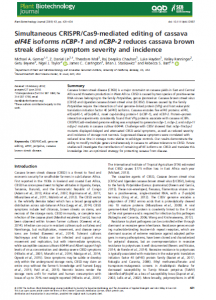Cassava brown streak disease (CBSD) is a major constraint on cassava yields in East and Central Africa and threatens production in West Africa. CBSD is caused by two species of positive sense RNA viruses belonging to the family Potyviridae, genus Ipomovirus: Cassava brown streak virus (CBSV) and Ugandan cassava brown streak virus (UCBSV). Diseases caused by the family Potyviridae require the interaction of viral genomelinked protein (VPg) and host eukaryotic translation initiation factor 4E (eIF4E) isoforms. Cassava encodes five eIF4E proteins: eIF4E,eIF(iso)4E1, eIF(iso)4E-2, novel cap-binding protein-1 (nCBP-1), and nCBP-2. Protein-protein interaction experiments consistently found that VPg proteins associate with cassava nCBPs. CRISPR/Cas9-mediated genome editing was employed to generate ncbp-1, ncbp-2, and ncbp-1/ncbp-2 mutants in cassava cultivar 60444. Challenge with CBSV showed that ncbp-1/ncbp-2 mutants displayed delayed and attenuated CBSD aerial symptoms, as well as reduced severity and incidence of storage root necrosis. Suppressed disease symptoms were correlated with reduced virus titre in storage roots relative to wild-type controls. Our results demonstrate the ability to modify multiple genes simultaneously in cassava to achieve tolerance to CBSD. Future studies will investigate the contribution of remaining eIF4E isoforms on CBSD and translate this knowledge into an optimised strategy for protecting cassava from disease.
Region: Africa
Date published:
2018
Published by:
Plant Biotechnology Journal
Type of resource:
Journal article
Resource topic:
Cassava
Project/Programme: Not specific
Pest/Disease: Cassava brown streak virus
Pages:
14
File type:
External link (1,392 KB)




